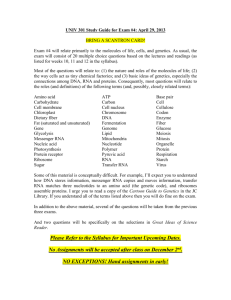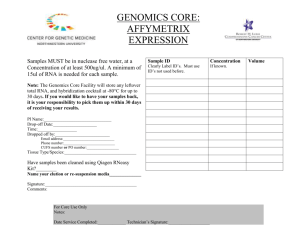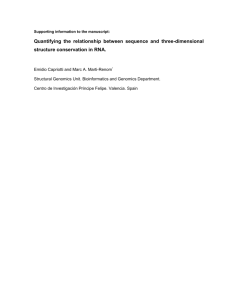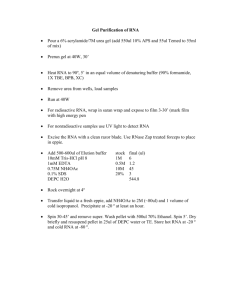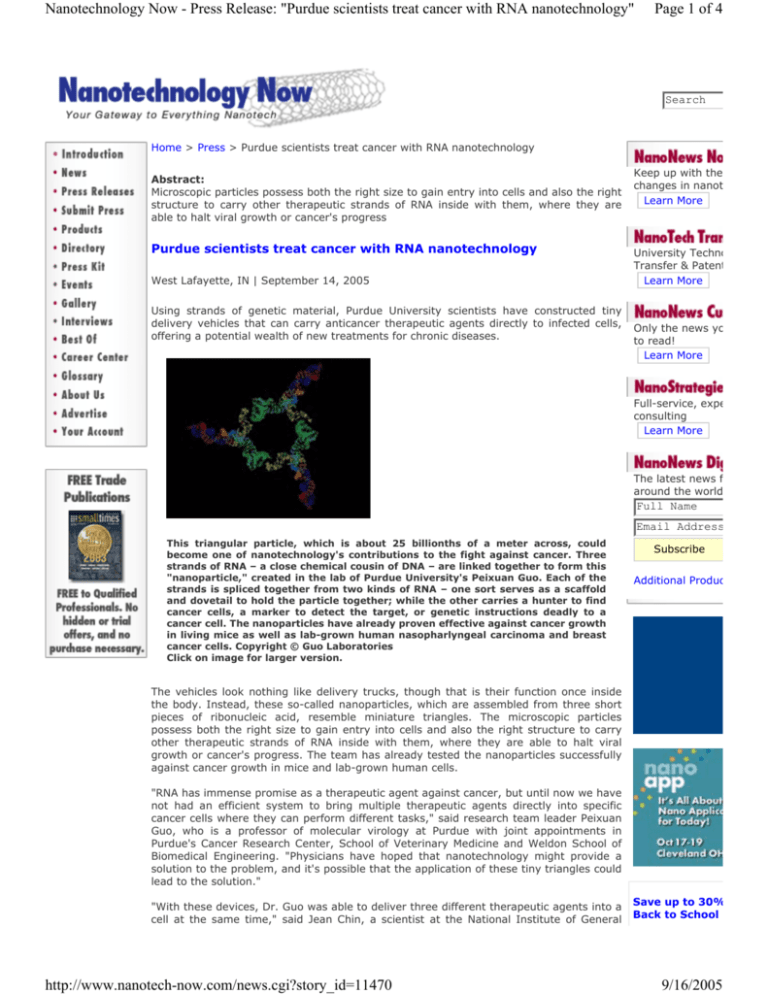
Nanotechnology Now - Press Release: "Purdue scientists treat cancer with RNA nanotechnology"
Page 1 of 4
Search
Home > Press > Purdue scientists treat cancer with RNA nanotechnology
Abstract:
Microscopic particles possess both the right size to gain entry into cells and also the right
structure to carry other therapeutic strands of RNA inside with them, where they are
able to halt viral growth or cancer's progress
Purdue scientists treat cancer with RNA nanotechnology
West Lafayette, IN | September 14, 2005
Using strands of genetic material, Purdue University scientists have constructed tiny
delivery vehicles that can carry anticancer therapeutic agents directly to infected cells,
offering a potential wealth of new treatments for chronic diseases.
Keep up with the
changes in nanot
Learn More
University Techno
Transfer & Patent
Learn More
Only the news yo
to read!
Learn More
Full-service, expe
consulting
Learn More
The latest news f
around the world
Full Name
Email Address
This triangular particle, which is about 25 billionths of a meter across, could
become one of nanotechnology's contributions to the fight against cancer. Three
strands of RNA – a close chemical cousin of DNA – are linked together to form this
"nanoparticle," created in the lab of Purdue University's Peixuan Guo. Each of the
strands is spliced together from two kinds of RNA – one sort serves as a scaffold
and dovetail to hold the particle together; while the other carries a hunter to find
cancer cells, a marker to detect the target, or genetic instructions deadly to a
cancer cell. The nanoparticles have already proven effective against cancer growth
in living mice as well as lab-grown human nasopharlyngeal carcinoma and breast
cancer cells. Copyright © Guo Laboratories
Click on image for larger version.
Subscribe
Additional Produc
The vehicles look nothing like delivery trucks, though that is their function once inside
the body. Instead, these so-called nanoparticles, which are assembled from three short
pieces of ribonucleic acid, resemble miniature triangles. The microscopic particles
possess both the right size to gain entry into cells and also the right structure to carry
other therapeutic strands of RNA inside with them, where they are able to halt viral
growth or cancer's progress. The team has already tested the nanoparticles successfully
against cancer growth in mice and lab-grown human cells.
"RNA has immense promise as a therapeutic agent against cancer, but until now we have
not had an efficient system to bring multiple therapeutic agents directly into specific
cancer cells where they can perform different tasks," said research team leader Peixuan
Guo, who is a professor of molecular virology at Purdue with joint appointments in
Purdue's Cancer Research Center, School of Veterinary Medicine and Weldon School of
Biomedical Engineering. "Physicians have hoped that nanotechnology might provide a
solution to the problem, and it's possible that the application of these tiny triangles could
lead to the solution."
"With these devices, Dr. Guo was able to deliver three different therapeutic agents into a
cell at the same time," said Jean Chin, a scientist at the National Institute of General
http://www.nanotech-now.com/news.cgi?story_id=11470
Save up to 30%
Back to School
9/16/2005
Nanotechnology Now - Press Release: "Purdue scientists treat cancer with RNA nanotechnology"
Page 2 of 4
Medical Sciences, which is part of the National Institutes of Health. "This is an incredible
accomplishment that points to the versatility and potential medical value of these
nanoparticles."
The research appears in two related papers being published in the scientific journals
Nano Letters and Human Gene Therapy. Members of Guo's research team are from
Purdue, the University of Central Florida and the University of California, Riverside,
including Songchuan Guo, Annette Khaled, Feng Li, Sulma Mohammed and Nuska
Tschammer.
Guo's team created their nanoparticles by linking together different kinds of RNA, a task
that their previous research has given them ample opportunities to practice. Several
years after building a tiny "motor" from several strands of RNA that mimic those in a
bacteria-killing virus called phi29, the team learned how to manipulate these stringy
molecules into different shapes, including rods, triangles and arrays.
"We speculated at that time that these shapes would be useful purely as physical
scaffolding on which more sophisticated nanodevices could be constructed," Guo said.
"But RNA, which carries genetic messages within cells, also has many therapeutic
functions. We realized that if we built different kinds of therapeutic RNA onto the RNA
scaffolding and created a single structure, we might be able to respond to several
challenges that have confronted the medical field."
RNA molecules come in many variant forms, and the sort that the team mimicked from
the phi29 virus – called pRNA – also can be linked to other types of RNA to form longer,
hybrid strands with properties the researchers could assign.
"We looked around for RNA strands that would behave in certain ways when they
encounter a cancer cell because each of them needs to perform one step of the therapy,"
Guo explained. "An effective agent against cancer needs to accomplish several tasks. It
needs first to recognize the cancer cell and gain access to its interior, and then it needs
to destroy it. But we'd also like the agent to leave a trail for us, to mark the path the
molecule has taken somehow. That way, we can pinpoint the location of the cancer and
trace the outcome after the treatment."
To accomplish these tasks, the team turned to other forms of RNA that can interfere with
the goings-on inside cells. The team sorted through a variety of RNA forms that have
shown promise for disease treatment and found three that could perform each of the
desired tasks. One example is "small interfering RNA," or siRNA, which deactivates
certain genes in cells. The others are RNA aptamers, which bind to cancer cell surface
markers, and ribozymes, which can be designed to degrade specific RNA in cancer cells
or viruses.
"We linked each of the three therapeutic strands with a piece of pRNA, forming three
hybrid strands," Guo said. "Then, using techniques we learned from our earlier work, we
were able to combine all three into triangles that are between 25 and 40 nanometers
wide. This is the Goldilocks size for any nanoparticle that is to be used in the body – not
too big, not too small."
books!
Save on our hug
inventory of Ne
Used Textbooks
and get your bo
delivered to you
home or dorm i
days or less wit
Fast & Free
Delivery. Memb
save an addition
10%!
Task Force to St
Societal Implicat
Environmental, H
and Safety Data
Particles larger than about 100 nanometers are generally too large to pass through cell
membranes into the cell's interior, Guo said, and the body has a hard time retaining
particles smaller than 10 nanometers. But the tiny triangles fit, and they worked well
enough to interrupt the growth of human breast cancer cells and leukemia model
lymphocytes in laboratory experiments.
"One characteristic of cancer cells is that they do not stop growing, which is one reason
tumors develop," Guo said. "Once inside, the siRNA essentially instructs the cells to 'stop
not stopping.' The nanoparticles had done their work on the breast cancer cell cultures
within a few days."
Additionally, the team found that the nanoparticles completely block cancer development
in living mice. A group of mice that were in the process of developing cancer were tested
with the nanoparticles, and they did not develop the disease. A second group that was Subscribe to the
tested with mutated inactive RNA all developed tumors.
Forbes/Wolfe Nano
Report & Get 2 Fre
"The results are very promising, but we still have several hurdles to jump before we can Reports
test this therapy on people," Guo said. "First and foremost, we must ensure that it is as
http://www.nanotech-now.com/news.cgi?story_id=11470
9/16/2005
Nanotechnology Now - Press Release: "Purdue scientists treat cancer with RNA nanotechnology"
Page 3 of 4
Ads by Goooooogle
safe as we think it is. Some RNA can be toxic to noncancerous cells as well, and though
our nanoparticles appear to go straight to the cancer cells where we want them to go,
we have to be sure they do not go anywhere else before we can inject them into a living Nanotechnology
person."
Rocket stocks &
profit potential.
Stability of the RNA also is a factor the team must consider. Although they previously
Free report from
published data indicating that phi29 RNA nanoparticles are more stable than other RNA,
Guo said the team still needs to find better ways to protect the RNA from degradation by The Motley Fool.
www.fool.com
enzymes in the body.
Although the group still needs to prove the safety of their tiny creations, Guo said, they
remain confident that their work is a milestone for medical nanotechnology. The team
has already obtained further results that could help create safer RNA nanoparticles.
"Many studies have shown that therapeutic forms of RNA, such as siRNA or ribozymes,
could be put together to kill cancer, but the main obstacle has been finding the delivery
method that can bring them to specific cells simultaneously," Guo said. "Nanotechnology
is beginning to pay off here in that it may have provided us with a solution to the
problem. We hope to enhance the work we have done so far and refine it for human
trials."
The RNAi
Resource
Everything you
need to know abo
RNAi and gene
silencing.
www.ambion.com/RNA
The team's work is supported in part by grants from the National Institutes of Health and
the Department of Defense.
Guo is affiliated with Purdue's Cancer Center and Birck Nanotechnology Center.
RNA Interferenc
Global supplier o
The Cancer Center, one of just eight National Cancer Institute-designated basic-research RNAi Products. T
facilities in the United States, attempts to help cancer patients by identifying new meet your gene
molecular targets and designing future agents and drugs for effectively detecting and silencing needs!
treating cancer.
www.sigmaaldrich.com
The Birck Nanotechnology Center is located in Purdue's new Discovery Park, located on
the southwestern edge of campus. Programs include undergraduate teaching, graduate
research and technology-transfer initiatives with industry partners. Scientists in biology,
chemistry, physics and several engineering disciplines participate in the research.
Virology &
Writer: Chad Boutin, (765) 494-2081, cboutin@purdue.edu
Source: Peixuan Guo, (765) 494-7561, guop@purdue.edu
####
Contact:
Purdue News Service
(765) 494-2096
purduenews@purdue.edu
Biosafety Test
Fast, affordable
GMP Testing Viru
PCR, Mycoplasm
& Microbial
www.mvl-inc.com
Copyright © Purdue University
If you have a comment, please Contact us.
Related News Press
Possible Futures
Show Me A Sign September 15th, 2005
http://www.nanotech-now.com/news.cgi?story_id=11470
9/16/2005
Nanotechnology Now - Press Release: "Purdue scientists treat cancer with RNA nanotechnology"
Page 4 of 4
Helping Out a High-Temperature Superconductor September 15th, 2005
Nano-oscillators get in sync September 15th, 2005
Scanning for solutions beyond the bar code September 15th, 2005
Nanomedicine
pSivida Completes Manufacturing Infrastructure for BrachySil(TM) September 15th,
2005
Biophan CEO to Present Company's Technology Portfolio September 15th, 2005
Nano-Research Forms Basis of "Artificial Skin Layer" September 15th, 2005
Nanomaterials laboratory tries to remove obstacles September 15th, 2005
Events & Announcements
Nanodiamonds prove magnetic September 15th, 2005
SAMCO and NANO Electronics Limited Sign Licensing Agreement September 15th,
2005
Ireland’s R&D focus starting to pay off September 15th, 2005
NanoIreland International Symposium September 15th, 2005
© Copyright 1999-2005 7thWave, Inc. All Rights Reserved
http://www.nanotech-now.com/news.cgi?story_id=11470
PRIVACY POLICY :: CONTACT US :: STATS :: SITE MAP :: ADV
9/16/2005



